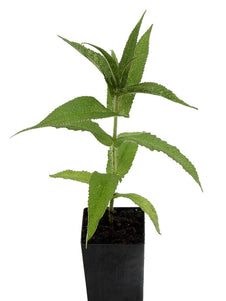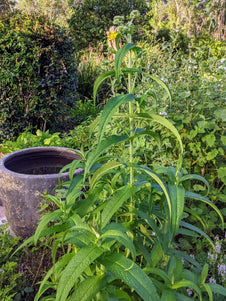







Boneset
Boneset
- Low stock - 16 items left
- Inventory on the way

Usually available: November to March
Life cycle: Herbaceous Perennial
Height: 80cm - 1.2m
Position: Sun / part shade
Soil preference: Moist / well drained
This is how we pack and send your Herb Plants to all states except TAS & WA
You will receive
- 1 Boneset Herb Plant in a 50 X 75mm tube - General growing instructions
All of our Herb Plants are grown organically with certified organic potting mixes and fertilizers
Botanical Name: Eupatorium perfoliatum
Common Boneset is a perennial growing to 1.2 meters, but may be smaller in some regions. The stem is erect, stout and cylindrical with branching at the top. Both the leaves and stem are hairy or downy. The leaves are quite distinctive in this species and have perforated ‘dots’ on the underside of the leaf leading to the species name. The mid green, lance shaped leaves are held opposite and connate, meaning united at the base. The leaves may be 10-20 cm long, tapering to a sharp point with finely toothed edges and prominent veins. The large flower heads appear in late spring to summer carrying 10-20 white florets above the leaves.
Common Boneset is distributed throughout eastern North America, from Quebec to Manitoba and south to Florida and Texas. The natural habitat of Boneset is wet and moist woodlands or damp grassland areas, but also in the sandy Texas soils. There are 30-60 species of Eupatorium, but there have been up to 800 in the genus prior to their scientific redistribution. Eupatorium perfoliatum, or Boneset, may go by other scientific synonyms.
A common name in the United States is Thoroughwort, again referring to the small perforations in the plant allowing people to see through the leaf. In old language, through and thorough were not distinguished. It may also be called Snake Root. The name Boneset is thought to be derived from its traditional use to treat a virus, possibly Dengue, which caused extreme limb or ‘bone breaking’ pain.
Growing Conditions
Boneset is happy in wet and moist areas, although it prefers the ground to be well drained. Full sun, through to woodland semi shade is acceptable. It will grow in a good range of soils, from sandy to clay, as noted above in the range of natural habitats. The plant is self- fertile and pollinated by insects. Seed should be sown in spring and if it is not warm enough this can be done in seed raising trays. They seedlings can then be planted out into the garden. Boneset is quite cold tolerant with temperatures as low as -25C being acceptable. Mature plants may be divided in spring and autumn.
Medicinal Uses
Boneset is a well known plant in the United States. It used for treating fevers in certain regions of the United States and the Native Americans used it traditionally to treat fevers by encouraging sweating. This herbal treatment is a popular medicine in North America where it is said to be unequalled in treating coughs, colds, influenza, bronchitis and fevers associated with these illnesses. It is also used for treating rheumatic illness, skin conditions and worms. Other uses include encouraging resistance to bacterial infections.
To harvest the plant, for medicinal use, collect the leaves and flowering stems in summer just before the buds open and dry them for later use. There is a homeopathic remedy made from the fresh plant, which is harvested when it first comes into bloom. The taste is slightly bitter, mildly astringent and the plant is slightly aromatic. A hot infusion may be used for colds and fevers.
This species is poisonous to humans, livestock and other animals. However, when used in mild to moderate doses Boneset is also a persistent and slow acting general tonic. However, it should not be used long term, for example, beyond six months. Large doses are laxative and emetic and the plant contains pyrrolizidine alkaloids which can cause liver damage in large doses. Despite this concern, Boneset has a long history of medicinal use.
All information provided on this website is for informational purposes only. Please seek professional advice before commencing any treatment.





